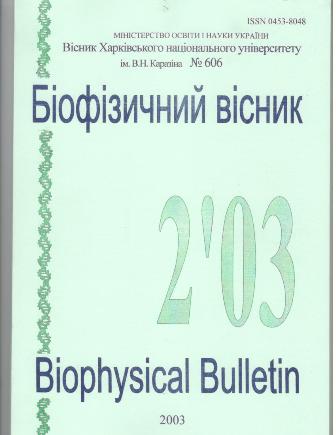Метод вычисления коэффициентов деполяризации геометрических объектов и биологических структур произвольной формы
Анотація
Разработан эффективный алгоритм и программа для расчета коэффициентов деполяризации тел произвольной формы методом дискретного приближения. Рассчитаны коэффициенты деполяризации таких геометрических форм как плоский диск, сфера, цилиндр, полусфера, конус, октаэдр, спираль, модели пространственной структуры сывороточного альбумина (heart-shape) и реальной структуры сывороточного альбумина человека, построенной на основе рентгеноструктурных координат (Protein Data Bank, структура 1bm0).
Завантаження
Посилання
Gatash S, Gorobchenko O, Khorunzhaya O, Kashpur V, Maleev V. Dielectric permittivity of heterogeneous disperse systems with particles of various shapes and structure under influence of physical factors. 2th International Conference “Broadband Dielectric Spectroscopy and its Applications’’. Leipzig. 2002.
Stepin LD. Issledovanie dijelektricheskih svojstv dispersnyh sistem. Dissertacija. Har'kov. 1965. 196p.
Landau LD, Lifshic EM. Jelektrodinamika sploshnyh sred. IFML. M. 1959. 532p.
Draine BT. Discrete-dipole approximation and it’s application to the interstellar graphite grains. Astrophys. J. 1988;333:848-872.
Draine BT, Flatau PJ. Iscrete-dipole approximation for scattering calculations. J. Opt. Soc. Am. A. 1994;11:1491-8.
Vajnshtejn BK. Biologicheskie kristally. Fizicheskij Jenciklopedicheskij slovar'. M.: Sov. Jenciklopedija; 1983.
Автори, які публікуються у цьому журналі, погоджуються з наступними умовами:
- Автори залишають за собою право на авторство своєї роботи та передають журналу право першої публікації цієї роботи на умовах ліцензії Creative Commons Attribution License, котра дозволяє іншим особам вільно розповсюджувати опубліковану роботу з обов'язковим посиланням на авторів оригінальної роботи та першу публікацію роботи у цьому журналі.
- Автори мають право укладати самостійні додаткові угоди щодо неексклюзивного розповсюдження роботи у тому вигляді, в якому вона була опублікована цим журналом (наприклад, розміщувати роботу в електронному сховищі установи або публікувати у складі монографії), за умови збереження посилання на першу публікацію роботи у цьому журналі.
- Політика журналу дозволяє і заохочує розміщення авторами в мережі Інтернет (наприклад, у сховищах установ або на особистих веб-сайтах) рукопису роботи, як до подання цього рукопису до редакції, так і під час його редакційного опрацювання, оскільки це сприяє виникненню продуктивної наукової дискусії та позитивно позначається на оперативності та динаміці цитування опублікованої роботи (див. The Effect of Open Access).





